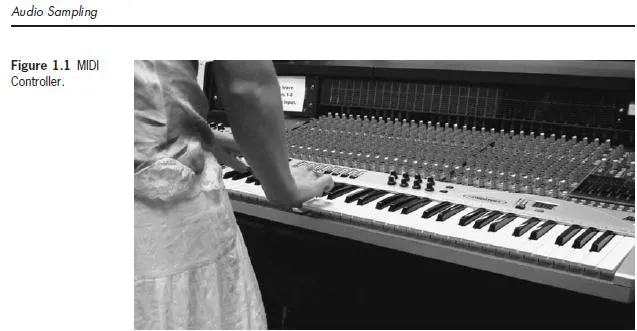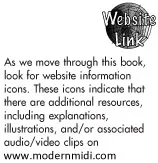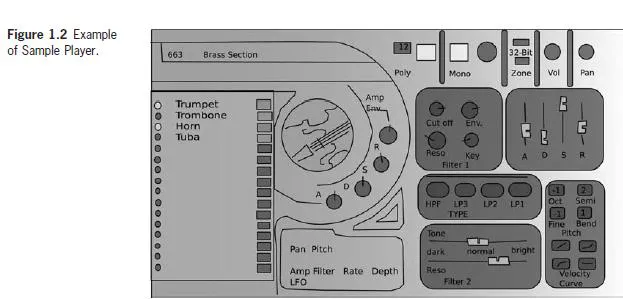
- 232 pages
- English
- ePUB (mobile friendly)
- Available on iOS & Android
eBook - ePub
About this book
Bringing sampling to a new generation of audio engineers and composers Audio Sampling explains how to record and create sampled instruments in a software setting. There are many things that go into creating a sampled instrument and many things that can go wrong, this book is a step by step guide through the process, from introducing sampling, where it begins to recording editing and using samples, providing much sought after detailed information on the actual process of sampling, creating sampled instruments as well as the different ways they can be used.
The software used is the NN-XT a sampler that is a part of the Reason studio software and ProTools LE, however the material discussed is applicable and can be used with any sampler.
The companion website has exclusive material including a comprehensive comparison of the different hardware software available, as well as audio examples and video clips from each stage of the process
Frequently asked questions
Yes, you can cancel anytime from the Subscription tab in your account settings on the Perlego website. Your subscription will stay active until the end of your current billing period. Learn how to cancel your subscription.
At the moment all of our mobile-responsive ePub books are available to download via the app. Most of our PDFs are also available to download and we're working on making the final remaining ones downloadable now. Learn more here.
Perlego offers two plans: Essential and Complete
- Essential is ideal for learners and professionals who enjoy exploring a wide range of subjects. Access the Essential Library with 800,000+ trusted titles and best-sellers across business, personal growth, and the humanities. Includes unlimited reading time and Standard Read Aloud voice.
- Complete: Perfect for advanced learners and researchers needing full, unrestricted access. Unlock 1.4M+ books across hundreds of subjects, including academic and specialized titles. The Complete Plan also includes advanced features like Premium Read Aloud and Research Assistant.
We are an online textbook subscription service, where you can get access to an entire online library for less than the price of a single book per month. With over 1 million books across 1000+ topics, we’ve got you covered! Learn more here.
Look out for the read-aloud symbol on your next book to see if you can listen to it. The read-aloud tool reads text aloud for you, highlighting the text as it is being read. You can pause it, speed it up and slow it down. Learn more here.
Yes! You can use the Perlego app on both iOS or Android devices to read anytime, anywhere — even offline. Perfect for commutes or when you’re on the go.
Please note we cannot support devices running on iOS 13 and Android 7 or earlier. Learn more about using the app.
Please note we cannot support devices running on iOS 13 and Android 7 or earlier. Learn more about using the app.
Yes, you can access Audio Sampling by Sam McGuire,Roy Pritts in PDF and/or ePUB format, as well as other popular books in Technology & Engineering & Acoustical Engineering. We have over one million books available in our catalogue for you to explore.
Information
INTRODUCTION TO SAMPLING 1
1.1 What Is Sampling?
This book is an introduction to the creation of virtual instruments through sampling. Sampling is the process of recording a sound source one part at a time, each part of which is then imported into a sampler. Typical parts include each note recorded from a musical instrument or singer. However, a sampler can be used with any recorded audio files. You could record yourself talking and each word could be a part of the sampled instrument. The sampler is used to organize the files into a playable instrument. A sampled instrument can be played using any MIDI controller ( Figure 1.1 ), such as a MIDI keyboard.
Sampled instruments are used in many different phases of the music production process. From the initial song creation to the final record production, samplers have made a signifi- cant impact on how musical tasks are accomplished. For example, samplers are often used during the demo creation process. A sampler can be used to play all of the instrumental parts of a demo. Using a sampler, instead of hiring musicians, can be a huge money saver because you can play all of the parts without having to pay other people. Using a sampler can also unleash the creative process. Even after a demo is created using a sampler, it can be easily tweaked and altered. There is very little turn-around time from hearing the mixed demo to making alterations. If you use actual musicians in the demo process, then they have to be called in for further recording sessions if changes need to be made. Using a sampler means freedom from relying on other people and their schedules. Throughout this book, we explore the many different parts of sampling.

Samplers are used to replicate sound sources with the potential for highly realistic results. Sampling is accomplished through several phases.
- • The sound source is recorded one part at a time. An example of this might include each note produced by a pitched instrument or a collection of percussive drum hits.
- • The recordings are edited.
- • The resulting files (samples) are mapped into the sampler. The mapping process involves assigning each sample to a zone that is associated with either a single key or a range of keys on a keyboard.
- • Finally, a MIDI sequencer or controller is used to trigger the samples.
While this is a simplified list, it accurately describes the core sampling process. Modern samplers have a wide range of features that are described later in this chapter. Some of the features are simple, while others are quite complex. This book is designed to explain each of these features in enough detail so that you can create your own virtual instruments. This chapter is also useful if you are trying to decide which type of sampler to purchase and use. Even if you are only interested in using sample libraries and not interested in creating your own sampled instrument, this book will help you to understand the sampling process and to use your samples in an effective manner.

Sampling is an effective tool because it uses a representative portion of a sound source to re-create the sound in an easily storable and recallable format. While a sampler is not able to reproduce most sound sources with the same level of variation as the original, it is able to achieve realistic results. The level of detail depends on how many samples are recorded and mapped into the sampler. It also depends on the specific sampler capabilities. Some samplers have features that allow for a higher level of realism. A realistic performance using a sampler depends less on the samples and the sampler capabilities and more on the performer’s abilities. In the end, the sampler is still only an instrument that can make no music by itself. The realism and musicality of a sampler depends on the performer.
Another related technology that is sometimes confused with sampling is modeling. Just like sampling, modeling is an extremely realistic method of creating virtual instruments. The creation of a modeled instrument is accomplished by taking a large number of detailed measurements of a sound source. This data is then programmed into a software application that can be used in the same way as a sampler. The process of creating a modeled instrument is similar in concept to sampling, but there are no recordings made or samples used. Instead, the instrument is created through mathematics and computer programming.
While modeling has come a long way, in many cases instruments created through sampling rather than modeling give better results. Even though a sampler might have less potential for natural variation than a modeled instrument, the sampled instrument’s strength lies in using actual recordings of the original sound source. Samplers are more accessible to end users who can tweak and create their own virtual instru ments. The sampling process is not limited to the accurate re-creation of sound sources but can also be used to form new sounds and instruments by combining and altering recorded samples. Sampling is a flexible and highly creative tool for everyone wanting to create their very own instrument.
MIDI (musical instrument digital interface) is a critical concept to understand when discussing samplers. While this text makes no attempt to fully explain MIDI (but see Section
2.13 in Chapter 2 and Sections 7.1 and 7.7 in Chapter 7, with additional resources listed), it is a very important part of sampler control. MIDI is a data exchange protocol used to send control information to samplers. Without MIDI, a sampler is only a fairly fancy audio file storage system. MIDI is used to trigger the audio files and create a performance. For clarity and simplicity, this text uses the terms triggered and played as synonyms when referring to a sampler being controlled through MIDI. For example, saying a sample was triggered is the same thing as saying the sample was played. Both refer to MIDI data controlling what the sampler does. In addition, while there is more than one type of MIDI controller, this text uses a piano-style MIDI keyboard as the default type, unless specified otherwise.
1.2 A Sampler Survey
There are a number of sampling technologies available, ranging from simple sample playback tools to complex sample creation machines. This large range of samplers, while providing options for a variety of skill levels and interests, creates confusion about which one should be used in different situations. This section covers the primary sampler categories and provides insight into practical applications for each category.
1.2.1Sample Players
While nearly all samplers ( Figure 1.2 ) have the ability to play prerecorded samples, there are some that are limited to playback and have no sample creation options. Many sample players are extremely powerful with high-quality sounds; they just can’t be tweaked past a certain point. For example, you may not be able to edit individual sample files. Hardware sample players commonly are keyboards that have a set of standard sounds, but you can also find rack-mountable units that provide sample libraries but have no music keyboard built in. Software sample players typically have a primary focus, such as orchestral instruments, choirs, or traditional rock instruments. Some sample players are focused on one specific group of instruments, whereas others have a more general mix of different instruments. Sample Players also come at a variety of prices. You can find software sample players with limited libraries that are very inexpensive, but sample players that come with large sample libraries can cost many times more. Not only do the sample players with large libraries cost a lot, but you might also need to have a dedicated hard drive to store the samples, adding further costs.


You might be asking yourself why you would want to buy a sample player that has limited functionality in comparison to a full-blown sample recorder/editor/player. There are several valid reasons, the first being availability. Some sample libraries are not available except as a part of a sample player. Some manufacturers prefer to keep their samples and programming in a proprietary player format that is not open to “under the hood” tweaks and alterations. If you want to use these samples, you must purchase their specific sample player. Some of the very best sample libraries are available only in sample player format.
Another valid reason to use a sample player is if you have no need for a full-blown sampler with complex features that you will never use. If you don’t plan to create your own instrument, then having a sampler might be too much. In this case, you can simply find a sample player with the sounds that you would like to use, and off you go. Be aware that several digital audio workstations (DAW) come with very capable sample players.
These particular players are seamlessly integrated into their specific host DAW. The reason they are included is to extend the software’s functionality and give the end user a reason to purchase that particular software among many different choices.
If you are using samples in a live setting, a good keyboard with built-in samples might be a desirable option. Having the samples built into the keyboard reduces the need for a computer and audio interface and also reduces potential problems that might occur during live performances. Using a single performance keyboard on stage reduces the amount of equipment and cabling required. By reducing the amount of equipment, you likewise reduce potential problems caused by such things as cables failure and incorrect connections.
Some entry-level keyboards are limited to the built-in sounds, but other keyboards have expansion slots for importing additional instrumental samples. Some sample players offer the ability to add more sounds from third-party manufacturers, but other sample players do not. You need to research the accepted formats for your specific sample player because not all sample libraries are of equal quality. You might be limited to certain library types.

1.2.2Hardware Samplers
While hardware samplers ( Figure 1.3 ) are no longer the primary sampler format, they are still being developed and can be used to create complex sampled instruments. The most popular modern hardware samplers come as part of keyboard and drum-pad workstations. These workstations typically have at least a built-in controller (keyboard or drum pads), MIDI input/output (I/O), microphone/line level inputs, master outputs, and a software-based sampler interface. Having all of the necessary functions in a single box is very convenient. There are also a number of samplers that are rack-mountable boxes that have MIDI I/O, microphones/ line level inputs, and master outputs.
There are several advantages and disadvantages to using hardware samplers. The primary advantage is that you have all the necessary tools (and often many more) for sampling. You don’t have to worry about compatibility between different parts of the sampling process; everything has been tested and designed to work efficiently. Another advantage is for the performing musician. Like the sample players described earlier, they don’t have a lot of separate components that have to be carried around and set up for every concert. Hardware sampler manufacturers take pride in offering reliable systems with high-quality sound libraries and a lot of sounds. Another advantage is the price. While some of these samplers are not cheap, they are still less expensive than an equivalent computer, audio interface, MIDI controller, and software package.

Figure 1.3 Example of Hardware Sampler.
As for the disadvantages, you will find that the best part of a hardware sampler for some people is the worst part for someone else. While a hardware sampler might have all of the needed components to create a sampled instrument, it may not offer as much flexibility as a software sampler. The software that is included with the typical hardware sampler is usually not expandable with third-party effects. This means you are limited to the specific software of the hardware sampler. In addition to limited flexibility, the controls are often harder to use because there is less screen space to see parameters and editing screens. The features of hardware samplers, while undoubtedly advanced, are often buried among a lot of different page layers on a tiny screen.
Hardware Samplers can often be expanded to increase their sounds and memory. This and other basic features are very similar to software samplers. The most obvious difference is in the packaging, but in the following section on software samplers, you will see other significant differences that demonstrate the increased power of the software sampler...
Table of contents
- Front Cover
- Title
- Copyright
- Contents
- Dedication
- Acknowledgements
- Foreword
- Preface
- 1 Introduction to sampling
- 2 Making connections
- 3 Source preparation
- 4 Recording the fi rst sample
- 5 Sample editing
- 6 Creating the instrument
- 7 Using samples
- 8 Examining the roots of sampling
- 9 Thoughts on the future of sampling
- Index